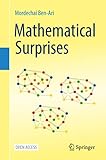Mathematical surprises
Publication details: Switzerland: Springer Cham, [c2022]Description: 226 pISBN: 9783031135651LOC classification: QA99Online resources: Click here to access online| Item type | Current library | Collection | Shelving location | Call number | Status | Date due | Barcode | Item holds |
|---|---|---|---|---|---|---|---|---|
 Book
Book
|
ICTS | Mathematics | Rack No 3 | QA99 (Browse shelf (Opens below)) | Checked out to Disha J Kuzhively (0007736371) | 09/05/2024 | 02803 |
Chapter 1: The Collapsing Compass
Chapter 2: Trisection of an Angle
Chapter 3: Squaring the Circle
Chapter 4: The Five-Color Theorem
Chapter 5: How to Guard a Museum
Chapter 6: Induction
Chapter 7: Solving Quadratic Equations
Chapter 8: Ramsey Theory
Chapter 9: Langford’s Problem
Chapter 10: The Axioms of Origami
Chapter 11: Lill’s Method and the Beloch Fold
Chapter 12: Geometric Constructions Using Origami
Chapter 13: A Compass Is Sufficient
Chapter 14: A Straightedge and One Circle is Sufficient
Chapter 15: Are Triangles with Equal Areas and Perimeters Congruent?
Chapter 16: Construction of a Regular Heptadecagon
This is open access book provides plenty of pleasant mathematical surprises. There are many fascinating results that do not appear in textbooks although they are accessible with a good knowledge of secondary-school mathematics. This book presents a selection of these topics including the mathematical formalization of origami, construction with straightedge and compass (and other instruments), the five- and six-color theorems, a taste of Ramsey theory and little-known theorems proved by induction.
Among the most surprising theorems are the Mohr-Mascheroni theorem that a compass alone can perform all the classical constructions with straightedge and compass, and Steiner's theorem that a straightedge alone is sufficient provided that a single circle is given. The highlight of the book is a detailed presentation of Gauss's purely algebraic proof that a regular heptadecagon (a regular polygon with seventeen sides) can be constructed with straightedge and compass.
Although the mathematics used in the book is elementary (Euclidean and analytic geometry, algebra, trigonometry), students in secondary schools and colleges, teachers, and other interested readers will relish the opportunity to confront the challenge of understanding these surprising theorems.
Supplementary material to the book can be found at https://github.com/motib/suprises.
---Summary provided by the publisher


There are no comments on this title.